Transient Thermal Effects in Sedimentary Basins with Normal Faults and Magmatic Sill Intrusions—A Sensitivity Study
Abstract
:1. Introduction
2. Methods
2.1. Thermal and Maturation Modeling
2.2. Restoration of Faults
2.3. Thermal Effects of Sills
3. Modeling Strategy and Results
3.1. Thermal Effect of Slip along a Single, Normal Fault
3.1.1. Fault Displacement
3.1.2. Time Span of Faulting and Deposition
3.1.3. Fault Angle
3.1.4. Thermal Conductivity and Specific Heat Capacity
3.1.5. Basal Heat Flow
3.2. Restoration Methods
3.3. Sill Intrusions in the Basin
4. Discussion
4.1. Transient Thermal Effects in Relation to Normal Fault Slip
4.2. Fault Restoration and Its Effect on Thermal Modeling
4.3. Fault Slip and Magmatic Intrusions
4.4. Limitations of the Study
4.4.1. Assumptions
4.4.2. Temperature Model
4.4.3. Kerogen Type
5. Concluding Remarks
- After fault slip, the basin is thermally unstable and is influenced by transient thermal effects that may last up to several million years. This implies that transient thermal effects should be accounted for if sills are emplaced after the structural events, as they might affect the pre-intrusion host-rock temperatures.
- With increasing fault displacement, the temperature effects of fault slip on either side of the fault zone increases, as does the time the basin is thermally unstable.
- For faulting and deposition occurring over a time span of more than 10 Myr, the basin is in, or close to, a steady state throughout the entire period. However, for the same basin, but with faulting and deposition occurring over less than 10 Myr, the basin is thermally unstable for ~10 Myr. This means that the shorter the time used on faulting and deposition, the longer is the time the basin is thermally unstable.
- Different fault angles barely influence the time the basin is in a transient state. All tested angles lead to steady state ~10 Myr after fault slip. However, different fault angles cause changes in the foot wall and hanging wall areas and thus affect the host-rock temperature and therefore the temperature effect of potential sills.
- Thermal conductivity is the parameter influencing pre-intrusion host-rock temperatures in the basin the most. As temperatures increase, so does the time needed for the basin to regain steady state after fault slip. For basins with identical temperature regimes, the specific heat capacity is the important property determining the time needed for the basin to regain steady state.
- The obtained temperatures in the basin increase with increasing basal heat flow, thereby increasing the time needed to arrive at a steady state after fault slip.
- Different restoration methods result in basins of different geometries, leading to temporary thermal differences mainly in the footwall part of the basin. The largest thermal differences are found between basins with fault restored to basin with non-restored fault.
- Disregarding transient thermal effects proceeding normal fault slip may lead to both under- or overestimation of pre-intrusion host-rock temperature. This will influence the calculated effects of intruded sills and has implications for the estimate of how magmatic intrusions influence hydrocarbon maturation and is particularly the case for sills intruding as clusters at multiple levels.
- A basin that has regained steady state after normal faulting has the highest potential host-rock temperature.
Author Contributions
Funding
Acknowledgments
Conflicts of Interest
Appendix A
References
- Schutter, S.R. Occurrences of hydrocarbons in and around igneous rocks. In Hydrocarbons in Crystalline Rocks; Petford, N., McCaffrey, K.J.W., Eds.; Geological Society, Special Publications: London, UK, 2003; Volume 214, pp. 35–68. [Google Scholar]
- Zou, C.; Zhang, G.; Zhu, R.; Yuan, X.; Zhao, X.; Hou, L.; Wen, B.; Wu, X. Volcanic Reservoirs in Petroleum Exploration: Petroleum Industry Press; Elsevier Inc.: Amsterdam, The Netherlands, 2013. [Google Scholar]
- Senger, K.; Planke, S.; Polteau, S.; Ogata, K.; Svensen, H. Sill emplacement and contact metamorphism in a siliciclastic reservoir on Svalbard, Arctic Norway. Nor. J. Geol. 2014, 94, 155–169. [Google Scholar]
- Schutter, S.R. Hydrocarbon occurrence and exploration in and around igneous rocks. In Hydrocarbons in Crystalline Rocks; Petford, N., McCaffrey, K.J.W., Eds.; Geological Society, Special Publications: London, UK, 2003; Volume 214, pp. 7–33. [Google Scholar]
- Svensen, H.; Planke, S.; Malthe-Sørenssen, A.; Jamtveit, B.; Myklebust, R.; Eidem, T.R.; Rey, S.S. Release of methane from a volcanic basin as a mechanism for initial Eocene global warming. Nature 2004, 429, 542–545. [Google Scholar] [CrossRef] [PubMed]
- Svensen, H.; Planke, S.; Corfu, F. Zircon dating ties NE Atlantic sill emplacement to initial Eocene global warming. J. Geol. Soc. 2010, 167, 433–436. [Google Scholar] [CrossRef]
- Fjeldskaar, W.; Helset, H.M.; Johansen, H.; Grunnaleite, I.; Horstad, I. Thermal modelling of magmatic intrusions in the Gjallar Ridge, Norwegian Sea: Implications for vitrinite reflectance and hydrocarbon maturation. Basin Res. 2008, 20, 143–159. [Google Scholar] [CrossRef]
- Aarnes, I.; Svensen, H.; Connolly, J.A.D.; Podladchikov, Y.Y. How contact metamorphism can trigger global climate changes: Modeling gas generation around igneous sills in sedimentary basins. Geochim. Et Cosmochim. Acta 2010, 74, 7179–7195. [Google Scholar] [CrossRef]
- Svensen, H.; Corfu, F.; Polteau, S.; Hammer, Ø.; Planke, S. Rapid magma emplacement in the Karoo Large Igneous Province. Earth Planet. Sci. Lett. 2012, 325–326, 1–9. [Google Scholar] [CrossRef]
- Moorcroft, D.; Tonnelier, N. Contact Metamorphism of Black shales in the Thermal Aureole of a dolerite sill within the Karoo Basin. In Origin and Evolution of the Cape Mountains and Karoo Basin, Regional Geology Reviews; Linol, B., de Wit, M.J., Eds.; Springer International Publishing: Cham, Switzerland, 2016; pp. 75–84. [Google Scholar]
- Othman, R.; Arouri, K.R.; Ward, C.R.; McKirdy, D.M. Oil generation by igneous intrusions in the northern Gunnedah Basin, Australia. Org. Geochem. 2001, 32, 1219–1232. [Google Scholar] [CrossRef]
- Monreal, F.R.; Villar, H.; Baudino, R.; Delpino, D.; Zencich, S. Modeling an atypical petroleum system: A case study of hydrocarbon generation, migration and accumulation related to igneous intrusions in the Neuquen Basin, Argentina. Mar. Pet. Geol. 2009, 26, 590–605. [Google Scholar] [CrossRef]
- Spacapan, J.B.; Palma, J.O.; Galland, O.; Manceda, R.; Rocha, E.; D’Odorico, A.; Leanza, H.A. Thermal impact of igneous sill-complexes on organic-rich formations and implications for petroleum systems: A case study in the northern Neuquén Basin, Argentina. Mar. Pet. Geol. 2018, 91, 519–531. [Google Scholar] [CrossRef]
- Wang, D.; Song, Y. Influence of different boiling points of pore water around an igneous sill on the thermal evolution of the contact aureole. Int. J. Coal Geol. 2012, 104, 1–8. [Google Scholar] [CrossRef]
- Wang, D.; Zhao, M.; Qi, T. Heat-transfer-model analysis of the thermal effect of intrusive sills on organic-rich host rocks in sedimentary basins. In Earth Sciences; Dar, I.A., Ed.; InTech: London, UK, 2012. [Google Scholar]
- Dow, W.G. Kerogen studies and geological interpretations. J. Geochem. Explor. 1977, 7, 79–99. [Google Scholar] [CrossRef]
- Bostick, N.H.; Pawlewicz, M.J. Paleotemperatures based on vitrinite reflectance of shales and limestones in igneous dike aureoles in the Upper Cretaceous Pierre Shale, Walsenburg, Colorado. In Hydrocarbon Source Rocks of the Greater Rocky Mountain Region; Woodward, J.G., Meissner, F.F., Clayton, C.J., Eds.; Rocky Mountain Association of Geologists Symposium: Denver, CO, USA, 1984; pp. 387–392. [Google Scholar]
- Raymond, A.C.; Murchison, D.G. Development of organic maturation in the thermal aureoles of sills and its relation to sediment compaction. FUEL 1988, 67, 1599–1608. [Google Scholar] [CrossRef]
- Aarnes, I.; Planke, S.; Trulsvik, M.; Svensen, H. Contact metamorphism and thermogenic gas generation in the Vøring and Møre basins, offshore Norway, during the Paleocene-Eocene thermal maximum. J. Geol. Soc. 2015, 172, 588–598. [Google Scholar] [CrossRef]
- Galushkin, Y.I. Thermal effects of igneous intrusions on maturity of organic matter: A possible mechanism of intrusion. Org. Geochem. 1997, 26, 645–658. [Google Scholar] [CrossRef]
- Aarnes, I.; Svensen, H.; Polteau, S.; Planke, S. Contact metamorphic devolatilization of shales in the Karoo Basin, South Africa, and the effects of multiple sill intrusions. Chem. Geol. 2011, 281, 181–194. [Google Scholar] [CrossRef]
- Wang, D. Comparable study on the effect of errors and uncertainties of heat transfer models on quantitative evaluation of thermal alteration in contact metamorphic aureoles: Thermophysical parameters, intrusion mechanism, pore-water volatilization and mathematical equations. Int. J. Coal Geol. 2012, 95, 12–19. [Google Scholar]
- Wang, D.; Song, Y.; Xu, H.; Ma, X.; Zhao, M. Numerical modeling of thermal evolution in the contact aureole of a 0.9 m thick dolerite dike in the Jurassic siltstone section from Isle of Skye, Scotland. J. Appl. Geophys. 2013, 89, 134–140. [Google Scholar] [CrossRef]
- Liu, E.; Wang, H.; Uysal, I.T.; Zhao, J.-X.; Wang, X.-C.; Feng, Y.; Pan, S. Paleogene igneous intrusion and its effect on thermal maturity of organic-rich mudstones in the Beibuwan Basin, South China Sea. Mar. Pet. Geol. 2017, 86, 733–750. [Google Scholar] [CrossRef]
- Sydnes, M.; Fjeldskaar, W.; Løtveit, I.F.; Grunnaleite, I.; Cardozo, N. The importance of sill thickness and timing of sill emplacement on hydrocarbon maturation. Mar. Pet. Geol. 2018, 89, 500–514. [Google Scholar] [CrossRef]
- Fjeldskaar, W.; Andersen, Å.; Johansen, H.; Lander, R.; Blomvik, V.; Skurve, O.; Michelsen, J.K.; Grunnaleite, I.; Mykkeltveit, J. Bridging the gap between basin modelling and structural geology. Reg. Geol. Metallog. 2017, 72, 65–77. [Google Scholar]
- Benfield, A.E. The effect of uplift and denudation on underground temperatures. J. Appl. Phys. 1949, 20, 66–70. [Google Scholar] [CrossRef]
- Birch, F. Flow of heat in the Front Range, Colorado. Geol. Soc. Am. Bull. 1950, 61, 567–630. [Google Scholar] [CrossRef]
- ter Voorde, M.; Bertotti, G. Thermal effects of normal faulting during rifted basin formation, 1. A finite difference model. Tectonophysics 1994, 240, 133–144. [Google Scholar] [CrossRef]
- Bertotti, G.; ter Voorde, M. Thermal effects of normal faulting during rifted basin formation, 2. The Lugano-Val Grande normal fault and the role of pre-existing thermal anomalies. Tectonophysics 1994, 240, 145–157. [Google Scholar] [CrossRef]
- Johnson, C.; Harbury, N.; Hurford, A.J. The role of extension in the Miocene denudation of the Nevado-Filábride Complex, Betic Cordillera (SE spain). Tectonics 1997, 16, 189–204. [Google Scholar] [CrossRef]
- Bertotti, G.; Seward, D.; Wijbrans, J.; ter Voorde, M.; Hurford, A.J. Crustal thermal regime prior to, during, and after rifting: A geochronological and modeling study of the Mesozoic South Alpine rifted margin. Tectonics 1999, 18, 185–200. [Google Scholar] [CrossRef]
- Ehlers, T.A.; Chapman, D.S. Normal fault thermal regimes: Conductive and hydrothermal heat transfer surrounding the Wasatch fault, Utah. Tectonophysics 1999, 312, 217–234. [Google Scholar] [CrossRef]
- Ehlers, T.A.; Armstrong, P.A.; Chapman, D.S. Normal fault thermal regimes and the interpretation of low-temperature thermochronometers. Phys. Earth Planet. Inter. 2001, 126, 179–194. [Google Scholar] [CrossRef]
- Lander, R.H.; Langfeldt, M.; Bonnell, L.; Fjeldskaar, W. BMT User’s Guide; Tectonor AS Proprietary Publication: Stavanger, Norway, 1994. [Google Scholar]
- Fjeldskaar, W. BMTTM—Exploration tool combining tectonic and temperature modeling: Business Briefing: Exploration & Production. Oil Gas Rev. 2003, 1–4. [Google Scholar]
- Sclater, J.G.; Christie, P.A.F. Continental stretching: An explanation of the post-mid-cretaceous subsidence of the central North Sea basin. J. Geophys. Res. 1980, 85, 3711–3739. [Google Scholar] [CrossRef]
- Čermác, V.; Rybach, L. Thermal properties: Thermal conductivity and specific heat of minerals and rocks. In Landolt-Börnstein Zahlenwerte und Functionen aus Naturwissenschaften und Technik, Neue Serie, Physikalische Eigenschaften der Gesteine; Angeneister, G., Ed.; Springer Verlag: Berlin/Heidelberg, Germany; New York, NY, USA, 1982; pp. 305–343. [Google Scholar]
- Tissot, B.P.; Welte, D.H. Petroleum Formation and Occurrence, 2nd ed.; Springer-Verlag: Berlin/Heidelberg, Germany, 1984. [Google Scholar]
- Dula, W.F. Geometric Models of Listric normal Faults and Rollover Folds. Am. Assoc. Pet. Geol. Bull. 1991, 75, 1609–1625. [Google Scholar]
- Fossen, H. Structural Geology; Cambridge University Press: Cambridge, UK, 2010. [Google Scholar]
- Osagiede, E.E.; Duffy, O.B.; Jackson, C.A.-L.; Wrona, T. Quantifying the growth history of seismically imaged normal faults. J. Struct. Geol. 2014, 66, 382–399. [Google Scholar] [CrossRef]
- Magee, C.; Maharaj, S.M.; Wrona, T.; Jackson, C.A.-L. Controls on the expression of igneous intrusions in seismic reflection data. Geosphere 2015, 11, 1024–1041. [Google Scholar] [CrossRef]
- Schofield, N.; Holford, S.; Millett, J.; Brown, D.; Jolley, D.; Passey, S.R.; Muirhead, D.; Grove, C.; Magee, C.; Murray, J.; et al. Regional Magma Plumbing and emplacement mechanisms of the Faroe-Shetland sill Complex: Implications for magma transport and petroleum systems within sedimentary basins. Basin Res. 2017, 29, 41–63. [Google Scholar] [CrossRef]
- Eide, C.H.; Schofield, N.; Lecomte, I.; Buckley, S.J.; Howell, J.A. Seismic interpretation of sill complexes in sedimentary basins: Implications for the sub-sill imaging problem. J. Geol. Soc. 2017, 175, 193–209. [Google Scholar] [CrossRef]
- Francis, E.A. Magma and sediment-I: Emplacement mechanism of late Carboniferous tholeiite sills in northern Britain. J. Geol. Soc. 1982, 139, 1–20. [Google Scholar] [CrossRef]
- Chevallier, L.; Woodford, A. Morpho-tectonics and mechanism of emplacement of the dolerite rings and sills of the western Karoo, South Africa. S. Afr. J. Geol. 1999, 102, 43–54. [Google Scholar]
- Galerne, C.Y.; Neumann, E.-R.; Planke, S. Emplacement mechanisms of sill complexes: Information from the geochemical architecture of the Golden Valley Sill Complex, South Africa. J. Volcanol. Geotherm. Res. 2008, 177, 425–440. [Google Scholar] [CrossRef]
- Galerne, C.Y.; Galland, O.; Neumann, E.-R.; Planke, S. 3D relationships between sills and their feeders: Evidence from the Golden Valley Sill Complex (Karoo Basin) and experimental modelling. J. Volcanol. Geotherm. Res. 2011, 202, 189–199. [Google Scholar] [CrossRef]
- Hansen, J.; Jerram, D.A.; McCaffrey, K.; Passey, S.R. Early Cenozoic saucer-shaped sills of the Faroe Islands: An example of intrusive styles in basaltic lava piles. J. Geol. Soc. 2011, 168, 159–178. [Google Scholar] [CrossRef]
- Richardson, J.A.; Connor, C.B.; Wetmore, P.H.; Connor, L.J.; Gallant, E.A. Role of sills in the development of volcanic fields: Insights from lidar mapping surveys of the San Rafael Swell, Utah. Geology 2015, 43, 1023–1026. [Google Scholar] [CrossRef]
- Eide, C.H.; Schofield, N.; Jerram, D.A.; Howell, J.A. Basin-scale architecture of deeply emplaced sill complexes: Jameson Land, East Greenland. J. Geol. Soc. 2016, 174, 23–40. [Google Scholar] [CrossRef]
- Walker, R.J.; Healy, D.; Kawanzaruwa, T.M.; Wright, K.A.; England, R.W.; McCaffrey, K.J.W.; Bubeck, A.A.; Stephens, T.L.; Farrell, N.J.C.; Blenkinsop, T.G. Igneous sills as a record of horizontal shortening: The San Rafael sub-volcanic field, Utah. Geol. Soc. Am. Bull. 2017, 129, 1052–1070. [Google Scholar] [CrossRef]
- Svensen, H.H.; Frolov, S.; Akhmanov, G.G.; Polozov, A.G.; Jerram, D.A.; Shiganova, O.V.; Melnikov, N.V.; Iyer, K.; Planke, S. Sills and gas generation in the Siberian Traps. Philos. Trans. R. Soc. A Math. Phys. Eng. Sci. 2018, 376, 1–18. [Google Scholar] [CrossRef]
- Svensen, H.H.; Polteu, S.; Cawthron, G.; Planke, S. Sub-volcanic Intrusions in the Karoo Basin, South Africa. In Physical Geology of Shallow Magmatic Systems: Dykes, Sills and Laccoliths (Advances in Volcanology); Breitkreuz, C., Rocchi, S., Eds.; Springer International Publishing AG: Cham, Switzerland, 2018; pp. 349–362. [Google Scholar]
- Lange, R.A.; Cashman, K.V.; Natrosky, A. Direct measurements of latent heat during crystallization and melting of a ugandite and an olivine basalt. Contrib. Mineral. Petrol. 1994, 118, 169–181. [Google Scholar] [CrossRef]
- Atkins, P.; de Paula, J.; Keller, J. Atkins’ Physical Chemistry; Oxford University Press: Oxford, UK, 2017. [Google Scholar]
- Svensen, H.; Planke, S.; Jamtveit, B.; Pedersen, T. Seep carbonate formation controlled by hydrothermal vent complexes: A case study from the Vøring Basin, the Norwegian Sea. Geo-Mar. Lett. 2003, 23, 351–358. [Google Scholar] [CrossRef]
- Svensen, H.; Planke, S.; Polozov, A.G.; Schmidbauer, N.; Corfu, F.; Podladchikov, Y.Y.; Jamtveit, B. Siberian gas venting and the end-Permian environmental crisis. Earth Planet. Sci. Lett. 2009, 277, 490–500. [Google Scholar] [CrossRef]
- Iyer, K.; Rüpke, L.; Galerne, C.Y. Modeling fluid flow in sedimentary basins with sill intrusions: Implications for hydrothermal venting and climate change. Geochem. Geophys. Geosyst. 2013, 14, 5244–5262. [Google Scholar] [CrossRef]
- Iyer, K.; Schmid, D.W.; Planke, S.; Millett, J. Modelling hydrothermal venting in volcanic sedimentary basins: Impact on hydrocarbon maturation and paleoclimate. Earth Planet. Sci. Lett. 2017, 467, 30–42. [Google Scholar] [CrossRef]
- Peace, A.; McCaffrey, K.; Imber, J.; Hobbs, R.; van Hunen, J.; Gerdes, K. Quantifying the influence of sill intrusion on the thermal evolution of organic-rich sedimentary rocks in nonvolcanic passive margins: An example from ODP 210–1276, offshore Newfoundland, Canada. Basin Res. 2017, 29, 249–265. [Google Scholar] [CrossRef]
- Allen, P.A.; Allen, J.R. Basin Analysis: Principles and Application to Petroleum Play Assessment, 3rd ed.; Wiley-Blackwell: Chichester, West Sussex, UK, 2014. [Google Scholar]
- Hendrie, D.B.; Kusznir, N.J.; Hunter, R.H. Jurassic extension estimates for the North Sea `triple junction’ from flexural backstripping: Implications for decompression melting models. Earth Planet. Sci. Lett. 1993, 116, 113–127. [Google Scholar] [CrossRef]
- Trommsdorf, V.; Piccardo, G.B.; Montrasio, A. From magmatism through metamorphism to sea floor emplacement of subcontinental Adria lithosphere during pre-Alpine rifting (Malenco, Italy). Schweiz. Mineral. Und Petrogr. Mitt. 1993, 73, 191–203. [Google Scholar]
- Somerton, W.H. Thermal properties and temperature-related behavior of rock/fluid systems. In Developments in Petroleum Sciences; Elsevier: Amsterdam, The Netherlands, 1992. [Google Scholar]
- Planke, S.; Rasmussen, T.; Rey, S.; Myklebust, R. Seismic characteristics and distribution of volcanic intrusions and hydrothermal vent complexes in the Vøring and Møre basins. In Petroleum Geology: North-West Europe and Global Perspectives—Proceedings of the 6th Petroleum Geology Conference; Dorè, A.G., Vining, B.A., Eds.; Geological Society: London, UK, 2005; pp. 833–844. [Google Scholar]
- Hanson, R.B.; Barton, M.D. Thermal development of Low-Pressure Metamorphic Belts: Results from two-dimensional numerical models. J. Geophys. Res. 1989, 94, 10363–10377. [Google Scholar] [CrossRef]
- Kennett, J.P.; Watkins, N.D.; Vella, P. Paleomagnetic Chronology of Pliocene-Early Pleistocene Climates and the Plio-Pleistocene Boundary in New Zealand. Science 1971, 171, 276–279. [Google Scholar] [CrossRef] [PubMed]
- Kennet, J.P.; Watkins, N.D. Late Miocene-Early Pliocene Paleomagnetic Stratigraphy, Paleoclimatology, and Biostratigraphy in New Zealand. Geol. Soc. Am. Bull. 1974, 85, 1385–1398. [Google Scholar] [CrossRef]
- Karlin, R.; Levi, S. Geochemical and sedimentological control of the magnetic properties of hemipelagic sediments. J. Geophys. Res. 1985, 90, 10373–10392. [Google Scholar] [CrossRef]
- Turner, G.M.; Roberts, A.P.; Laj, C.; Kissel, C.; Mazaud, A.; Guitton, S.; Christoffel, D.A. New paleomagnetic results from Blind River: Revised magnetostratigraphy and tectonic rotation of the Marlborough region, South Island, New Zealand. N. Z. J. Geol. Geophys. 1989, 32, 191–196. [Google Scholar] [CrossRef]
- Tric, E.; Laj, C.; Jéhanno, C.; Valet, J.-P.; Kissel, C.; Mazaud, A.; Iaccarino, S. High-resolution record of the Upper Olduvai transition from Po Valley (Italy) sediments: Support for dipolar transition geometry? Phys. Earth Planet. Inter. 1991, 65, 319–336. [Google Scholar] [CrossRef]
- Szmytkiewicz, A.; Zalewska, T. Sediment deposition and accumulation rates determined by sediment trap and 210Pb isotope methods in the Outer Puck Bay (Baltic Sea). Oceanologia 2014, 56, 85–106. [Google Scholar] [CrossRef]
- Peketi, A.; Mazumdar, A.; Joao, H.M.; Patil, D.J.; Usapkar, A.; Dewangan, P. Coupled C-S-Fe geochemistry in a rapidly accumulating marine sedimentary system: Diagenetic and depositional implications. Geochem. Geophys. Geosyst. 2015, 16, 2865–2883. [Google Scholar] [CrossRef]
- Graseman, B.; Mancktelow, N.S. Two-dimensional thermal modelling of normal faulting: The Simplon Fault zone, Central Alps, Switzerland. Tectonophysics 1993, 225, 155–165. [Google Scholar] [CrossRef]
- Gluyas, J.; Swarbrick, R. Petroleum Geosciences; Blackwell Publishing: Oxford, UK, 2015. [Google Scholar]
- Fjeldskaar, W.; Christie, O.H.J.; Midttømme, K.; Virnovsky, G.; Jensen, N.B.; Lohne, A.; Eide, G.I.; Balling, N. On the determination of thermal conductivity of sedimentary rocks and the significance for basin temperature history. Pet. Geosci. 2009, 15, 367–380. [Google Scholar] [CrossRef]
- Jackson, C.A.-L.; Schofield, N.; Golenkov, B. Geometry and controls on the development of igneous sill-related forced folds: A 2-D seismic reflection case study from offshore southern Australia. Geol. Soc. Am. Bull. 2013, 125, 1874–1890. [Google Scholar] [CrossRef]
- Galland, O.; Bertelsen, H.S.; Eide, C.H.; Guldstrand, F.; Haug, Ø.T.; Leanza, H.A.; Mair, K.; Palma, O.; Planke, S.; Rabbel, O.; et al. Storage and transport of magma in the layered crust—Formation of sills and related flat-lying intrusions. In Volcanic and Igneous Plumbing Systems, Understanding Magma Transport, Storage and Evolution in the Earth’s Crust; Burchardt, S., Ed.; Elsevier: Amsterdam, The Netherlands, 2018; pp. 113–138. [Google Scholar]
- Jain, S. Fundamentals of Physical Geology; Springer Geology: New Dehli, India, 2014. [Google Scholar]
- Podladchikov, Y.Y.; Wickham, S.M. Crystallization of Hydrous Magmas: Calculation of Associated Thermal Effects, Volatile Fluxes, and Isotopic Alteration. J. Geol. 1994, 102, 25–45. [Google Scholar] [CrossRef]
- Wang, D.; Manga, M. Organic matter maturation in the contact aureole of an igneous sill as a tracer of hydrothermal convection. J. Geophys. Res. Solid Earth 2015, 120, 4102–4112. [Google Scholar] [CrossRef]
- Annen, C. Factors affecting the thickness of thermal aureoles. Front. Earth Sci. 2017, 5, 1–13. [Google Scholar] [CrossRef]
- Hanson, R.B. The hydrodynamics of contact metamorphism. Geol. Soc. Am. Bull. 1995, 107, 595–611. [Google Scholar] [CrossRef]
- Gudmundsson, A.; Løtveit, I.F. Sills as Fractured Hydrocarbon Reservoir: Examples and Models; Geological Society London Special Publications: London, UK, 2012; Volume 374, pp. 252–271. [Google Scholar]
- Montanari, D.; Bonini, M.; Cori, G.; Agostini, A.; Ventisette, C.D. Forced folding above shallow magma intrusions: Insights on supercritical fluid flow from analogue modelling. J. Volcanol. Geotherm. Res. 2017, 345, 67–80. [Google Scholar] [CrossRef]
- Rybach, L. Amount and significance of radioactive heat sources in sediments. In Thermal Modelling in Sedimentary Basins; Burrus, J., Ed.; Technip: Paris, France, 1986; pp. 311–323. [Google Scholar]
- Keen, C.E.; Lewis, T. Measured radiogenic heat production in sediments from continental margin of eastern North America: Implications for petroleum generation. AAPG Bull. 1982, 66, 1402–1407. [Google Scholar]
- McKenna, T.E.; Sharp, J.M. Radiogenic heat production in sedimentary rocks of the Gulf of Mexico Basin, South Texas. AAPG Bull. 1998, 82, 484–496. [Google Scholar]
- Thomas, G.W. Principles of Hydrocarbon Reservoir Simulation, 2nd ed.; International Human Resources Development Corporation: Boston, MA, USA, 1982. [Google Scholar]
- Hageman, L.A.; Young, D.M. Applied Iterative Methods; New York Academic Press: New York, NY, USA, 1981. [Google Scholar]
- Young, D.M.; Jea, K.C. Generalized Conjugate Acceleration of Iterative Methods, Part 2: The Nonsymmetrizable Case; Report CNA-163; Center for Numerical Analyses, University of Texas at Austin: Austin, TX, USA, 1981. [Google Scholar]
- Appleyard, J.R.; Chesire, I.M. Nested factorization: Proceedings of the Seventh Symposium on Reservoir Simulation; SPE Paper 12264; Society of Petroleum Engineers of AIME: San Francisco, CA, USA, 1983. [Google Scholar]
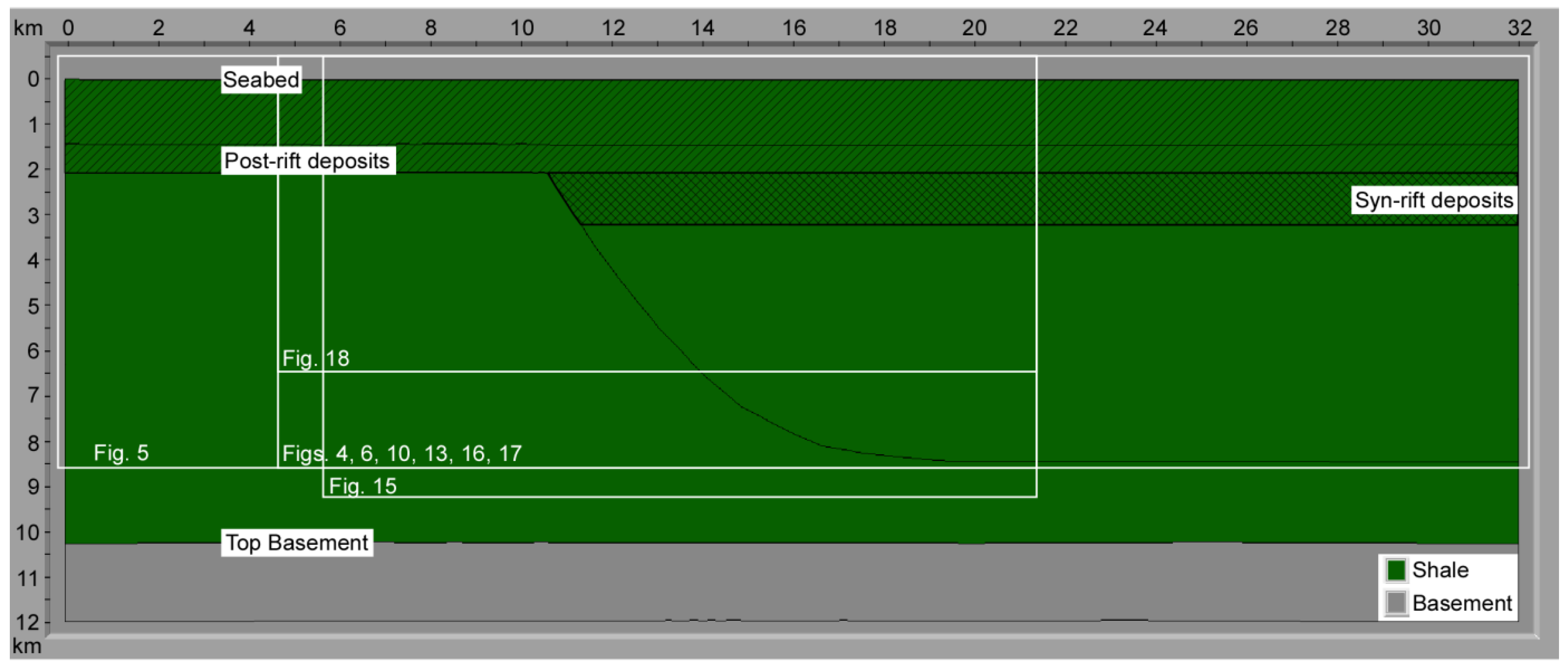

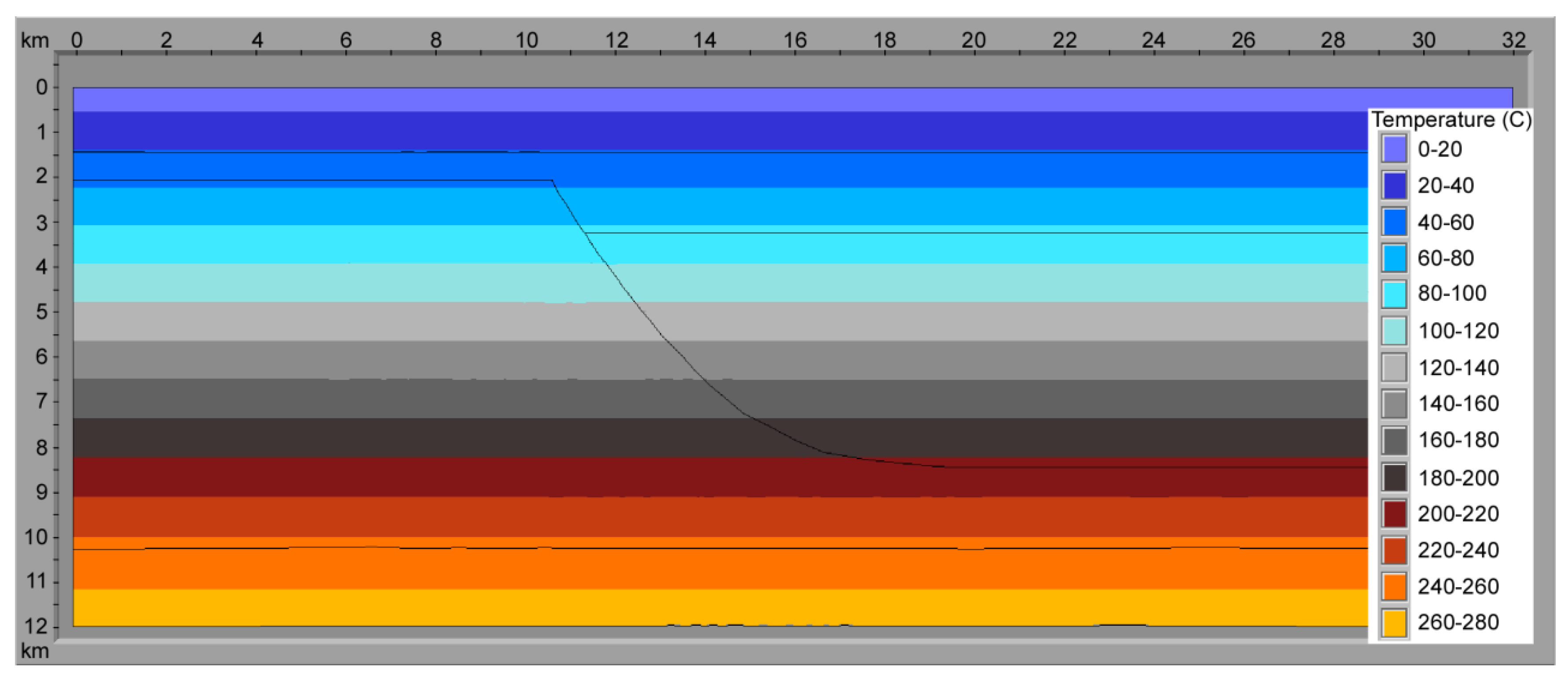
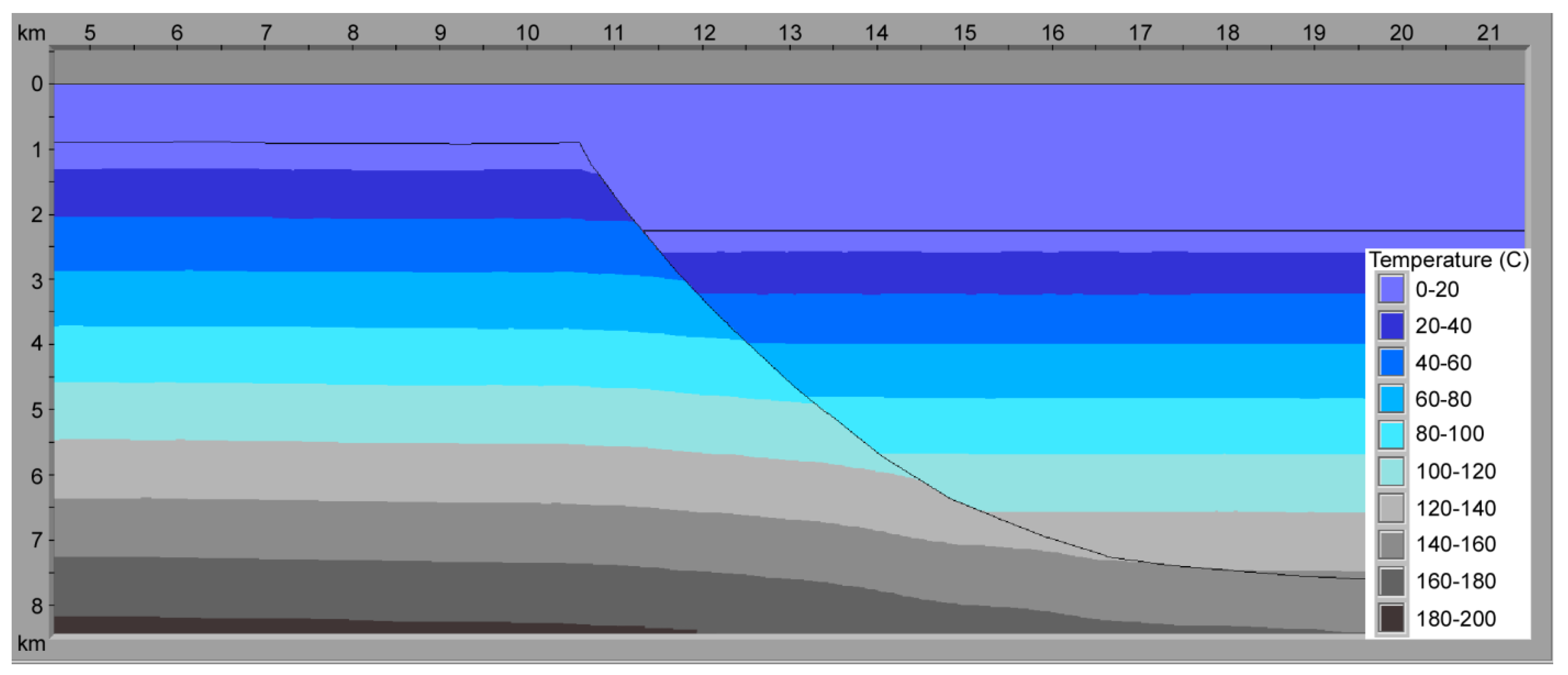
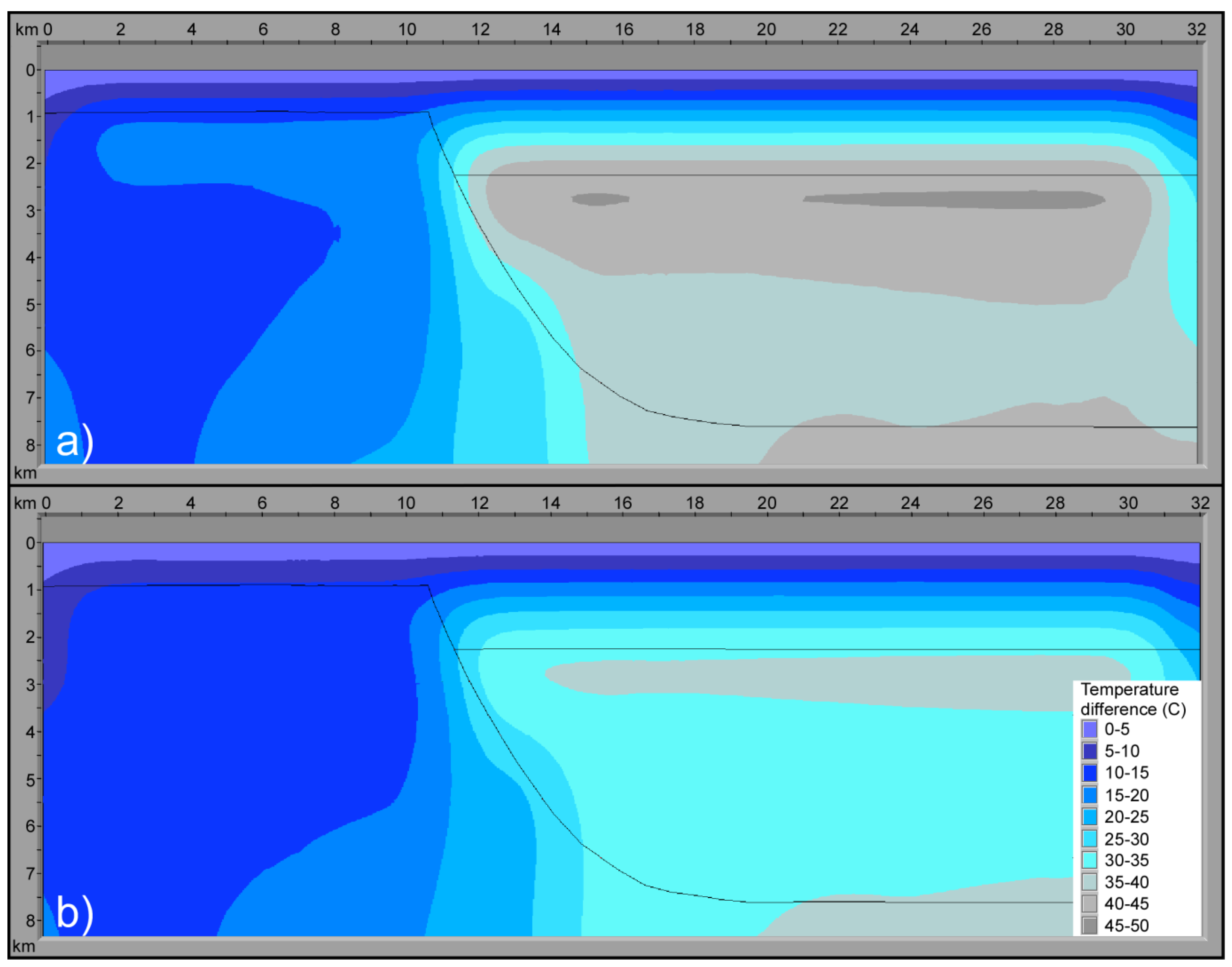
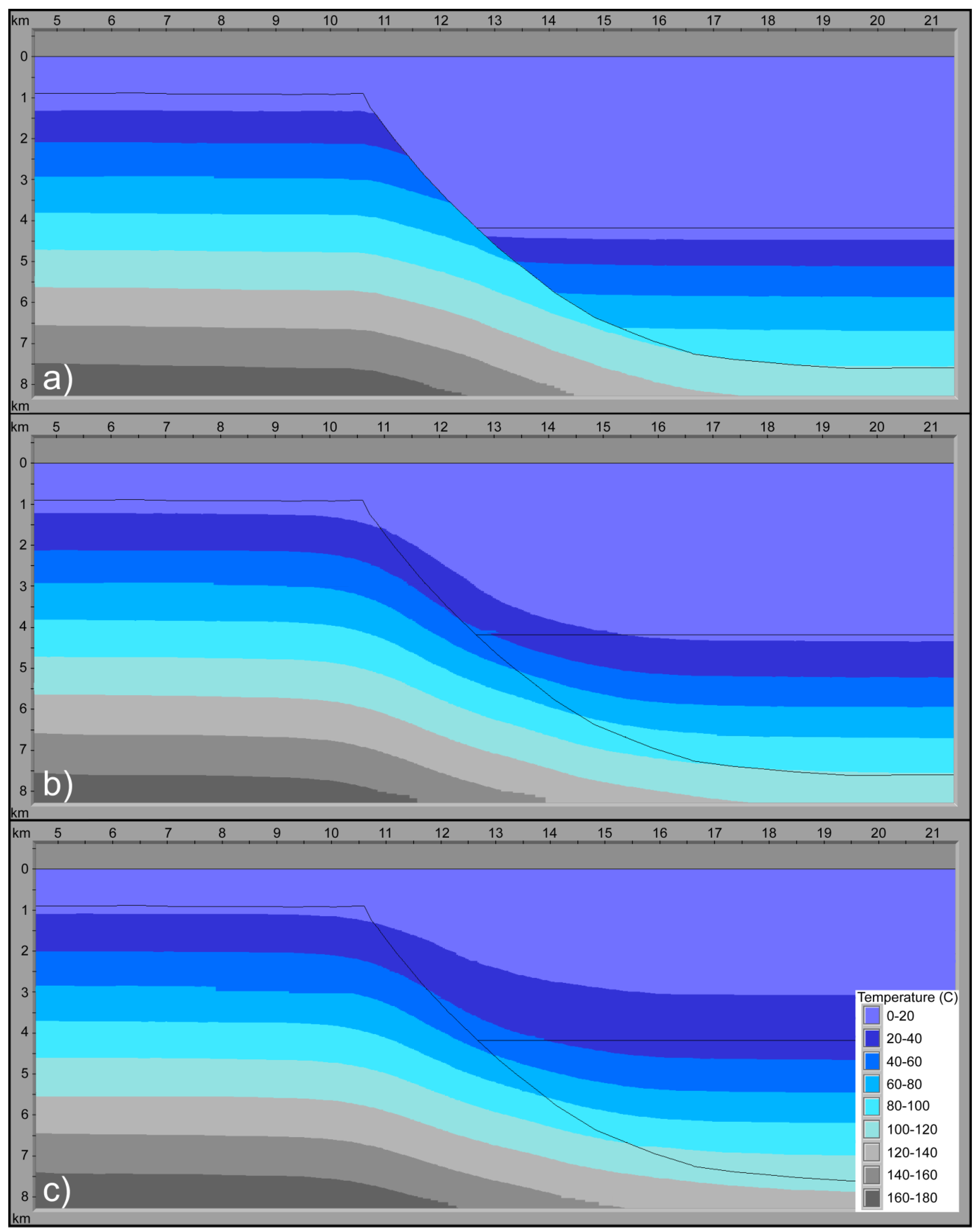
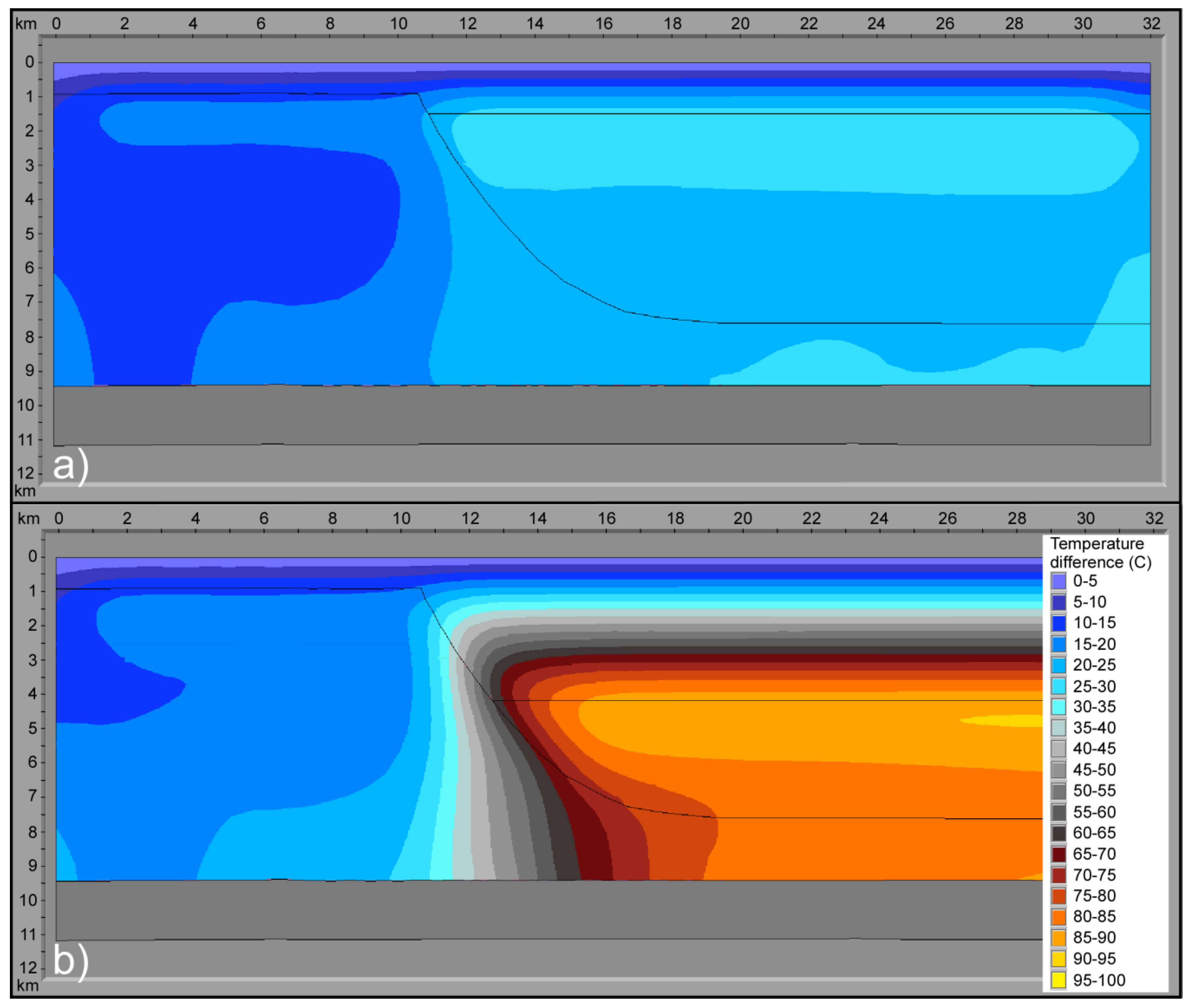
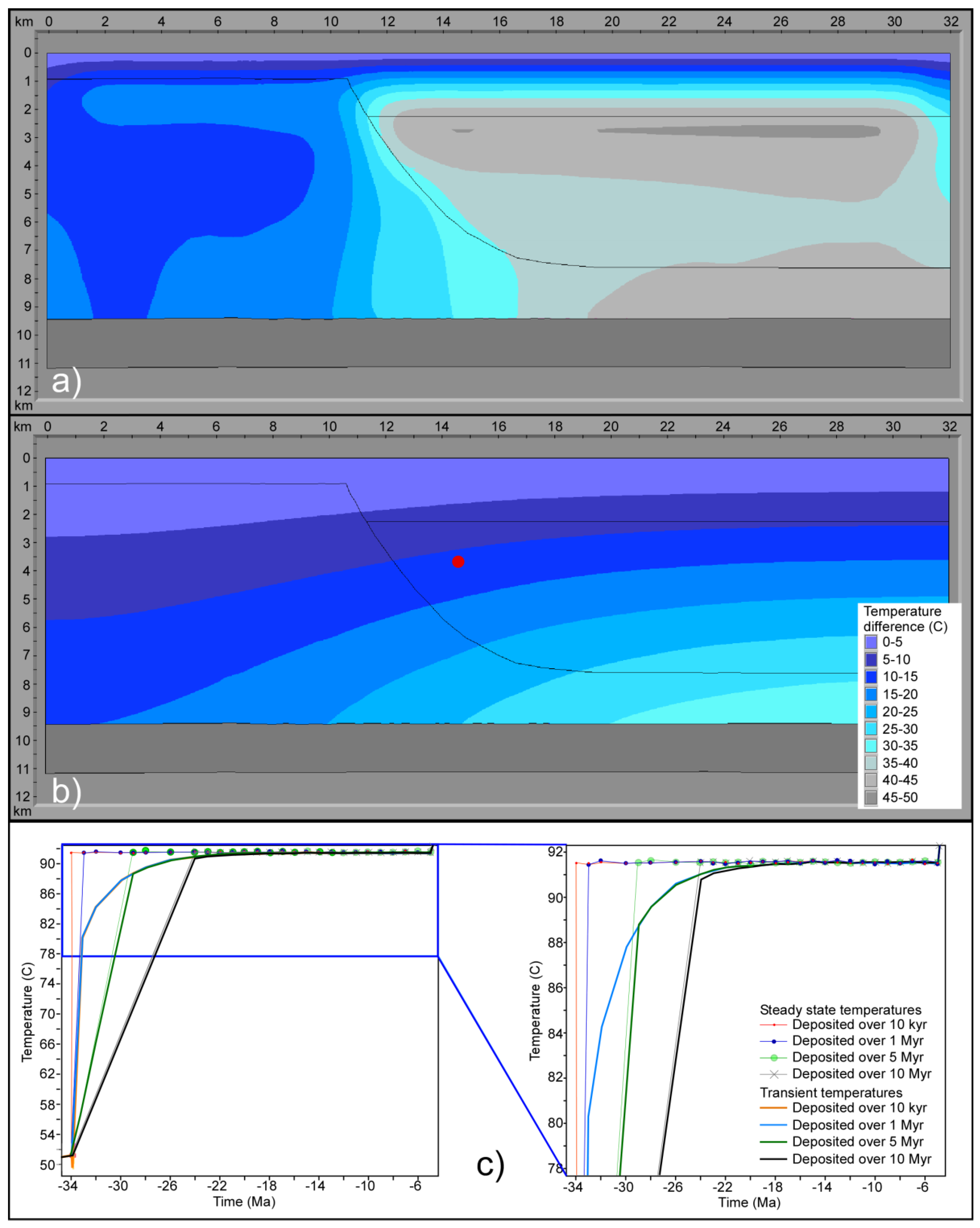

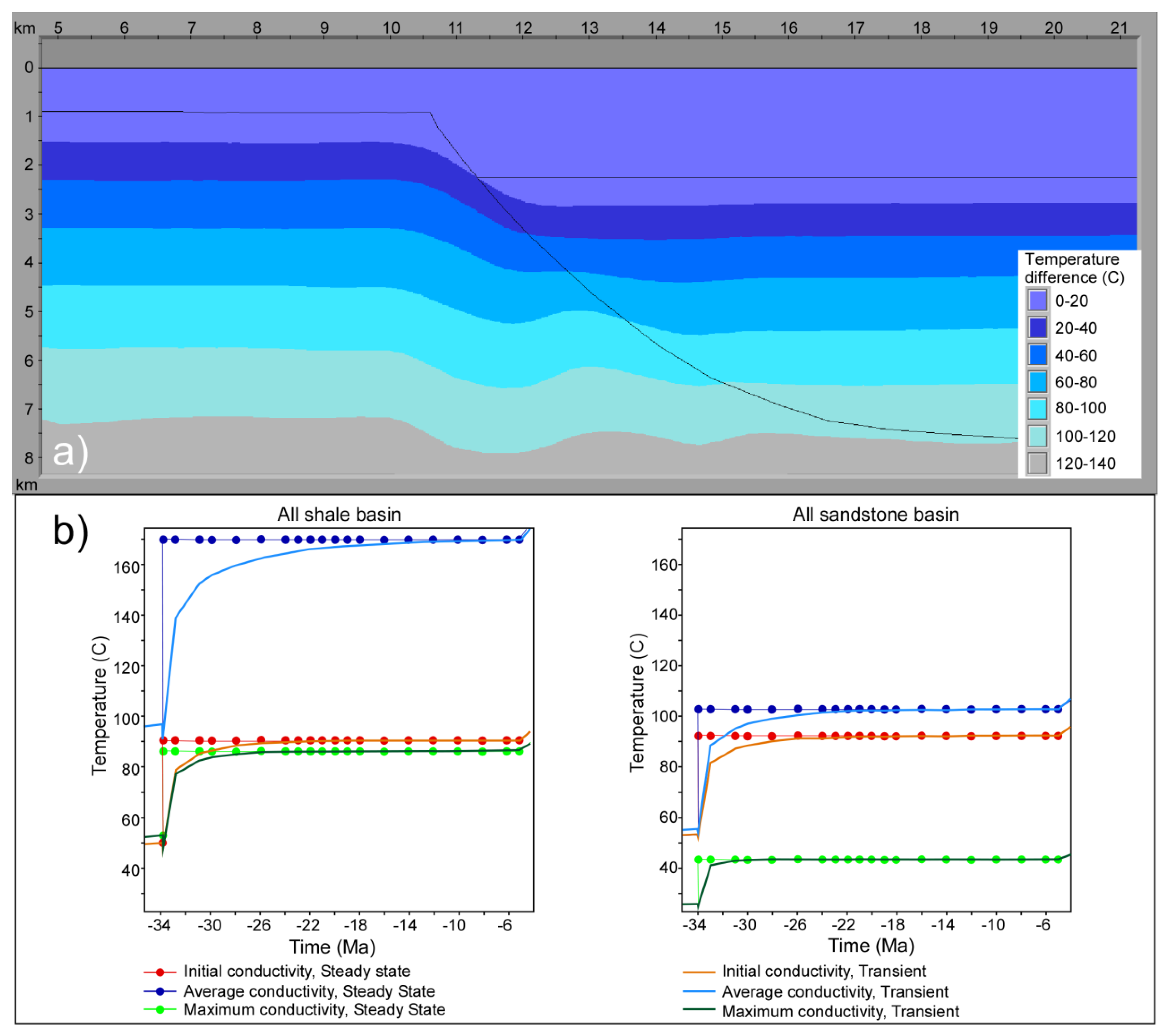
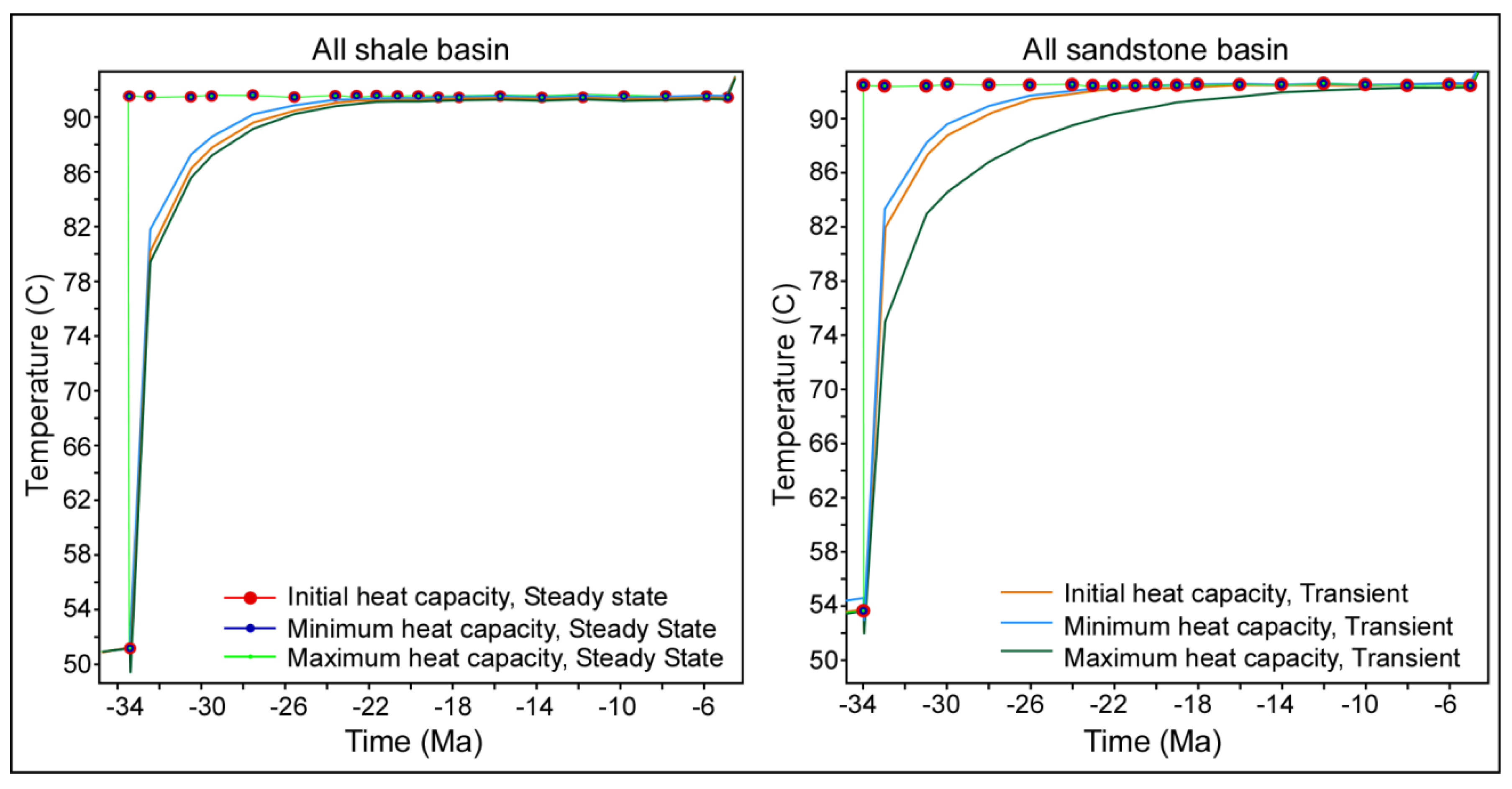

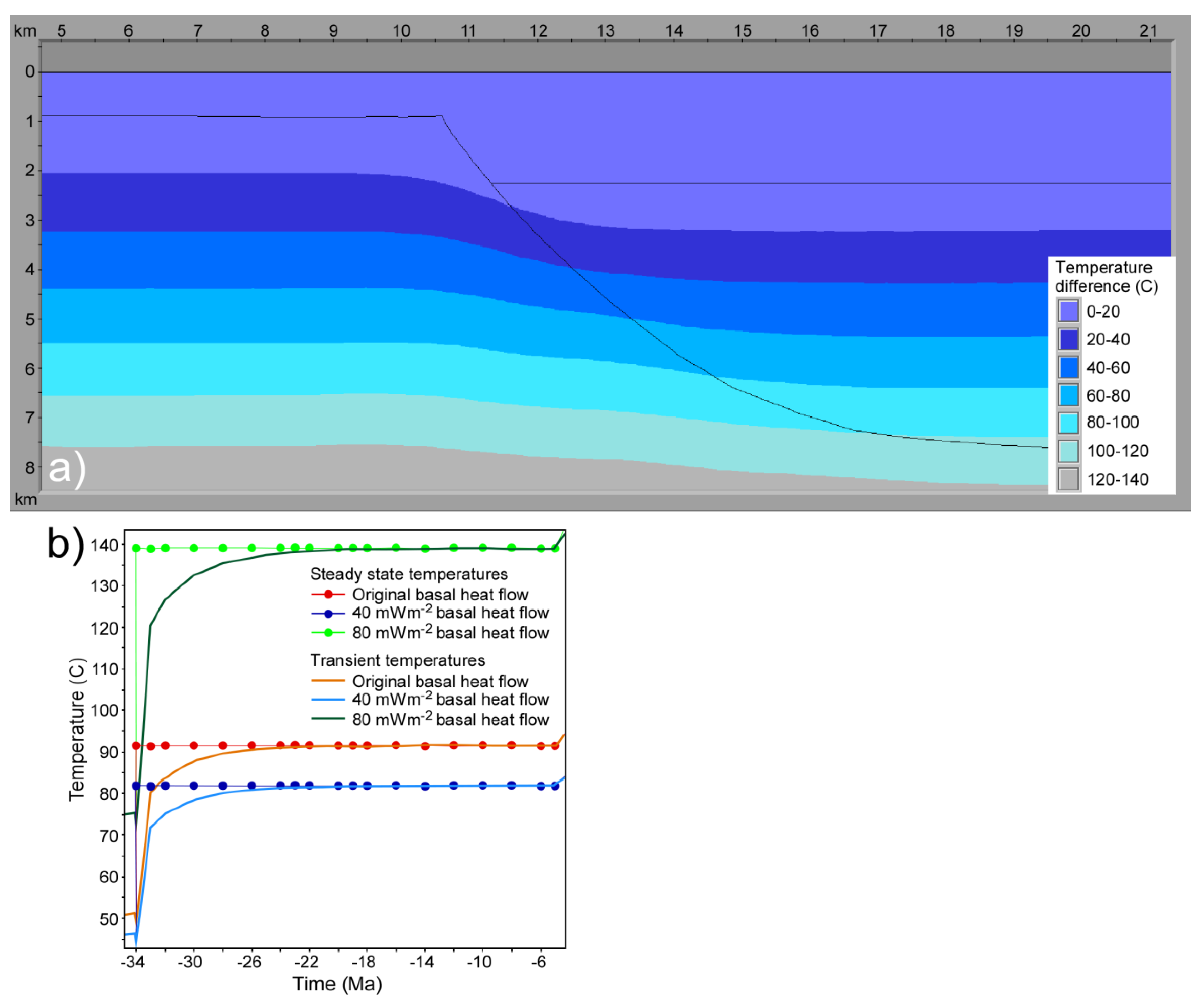
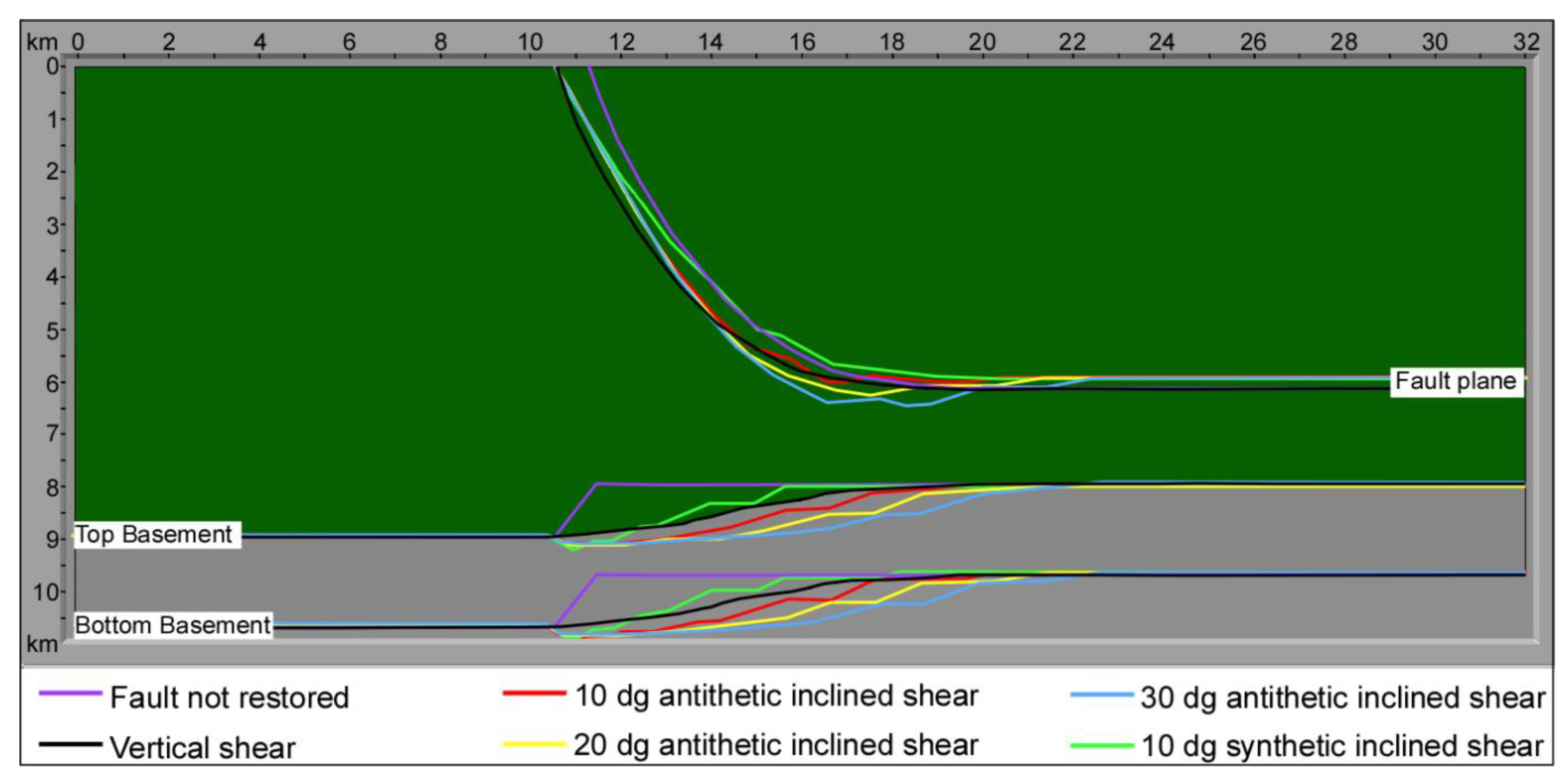
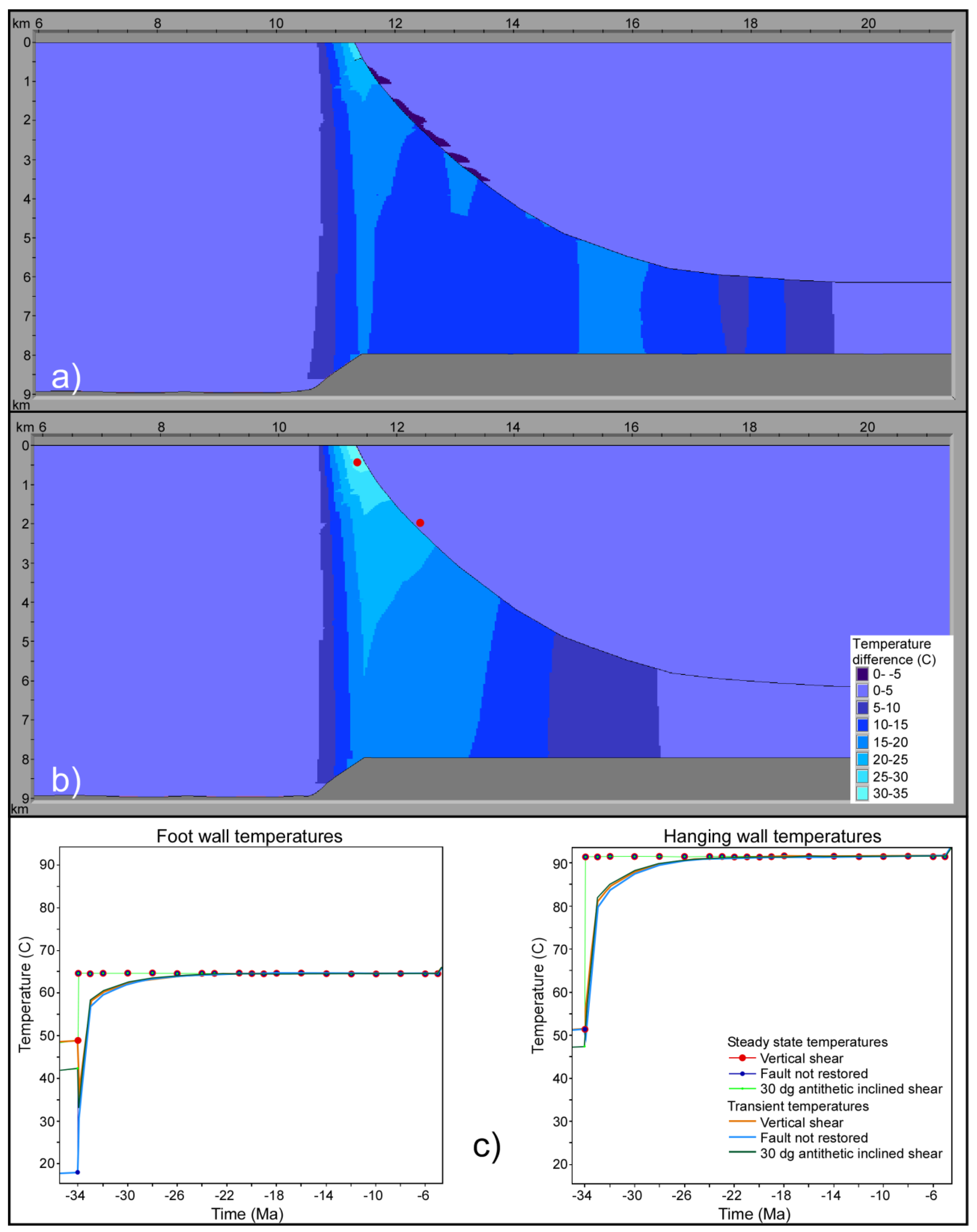

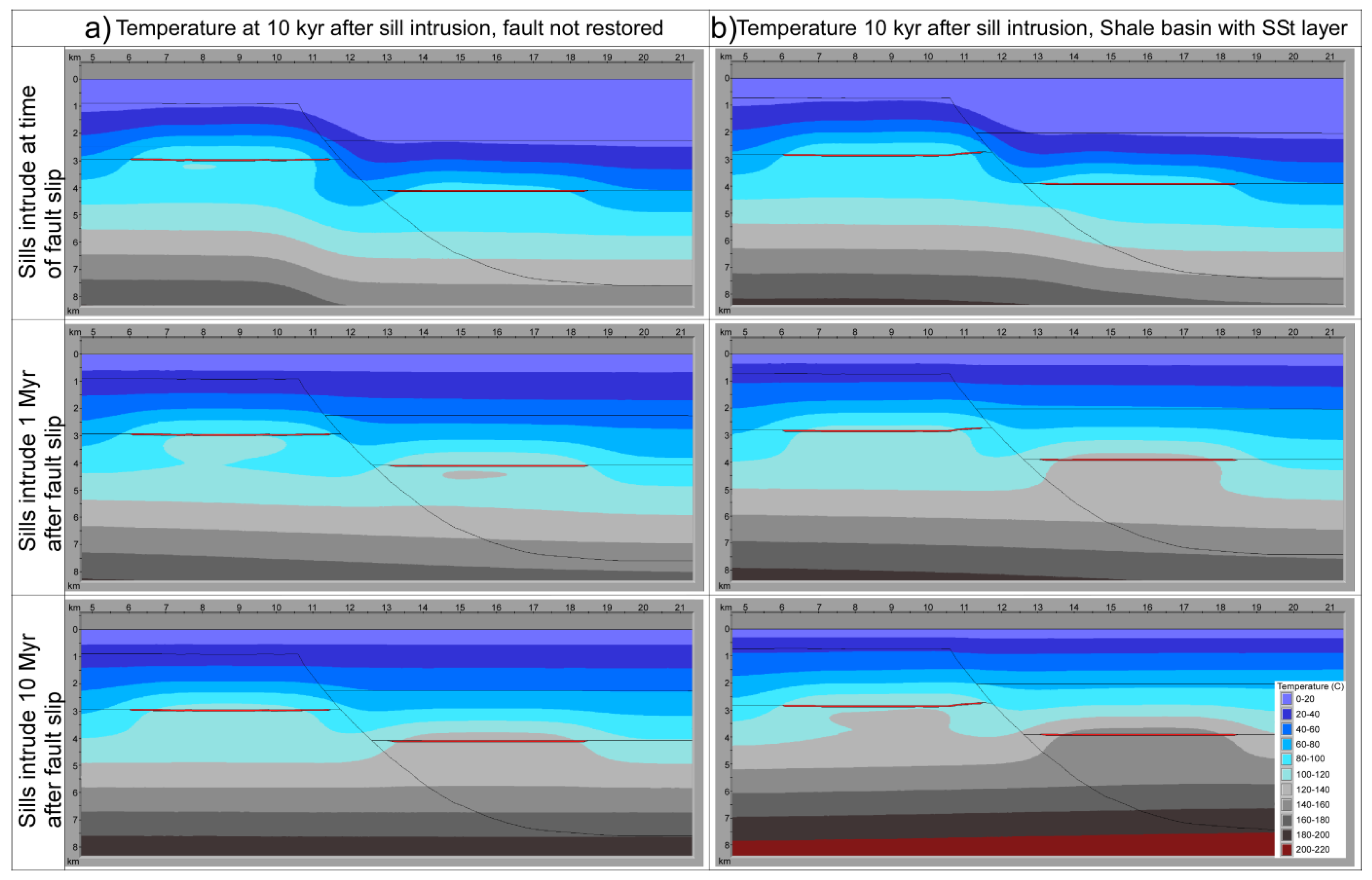
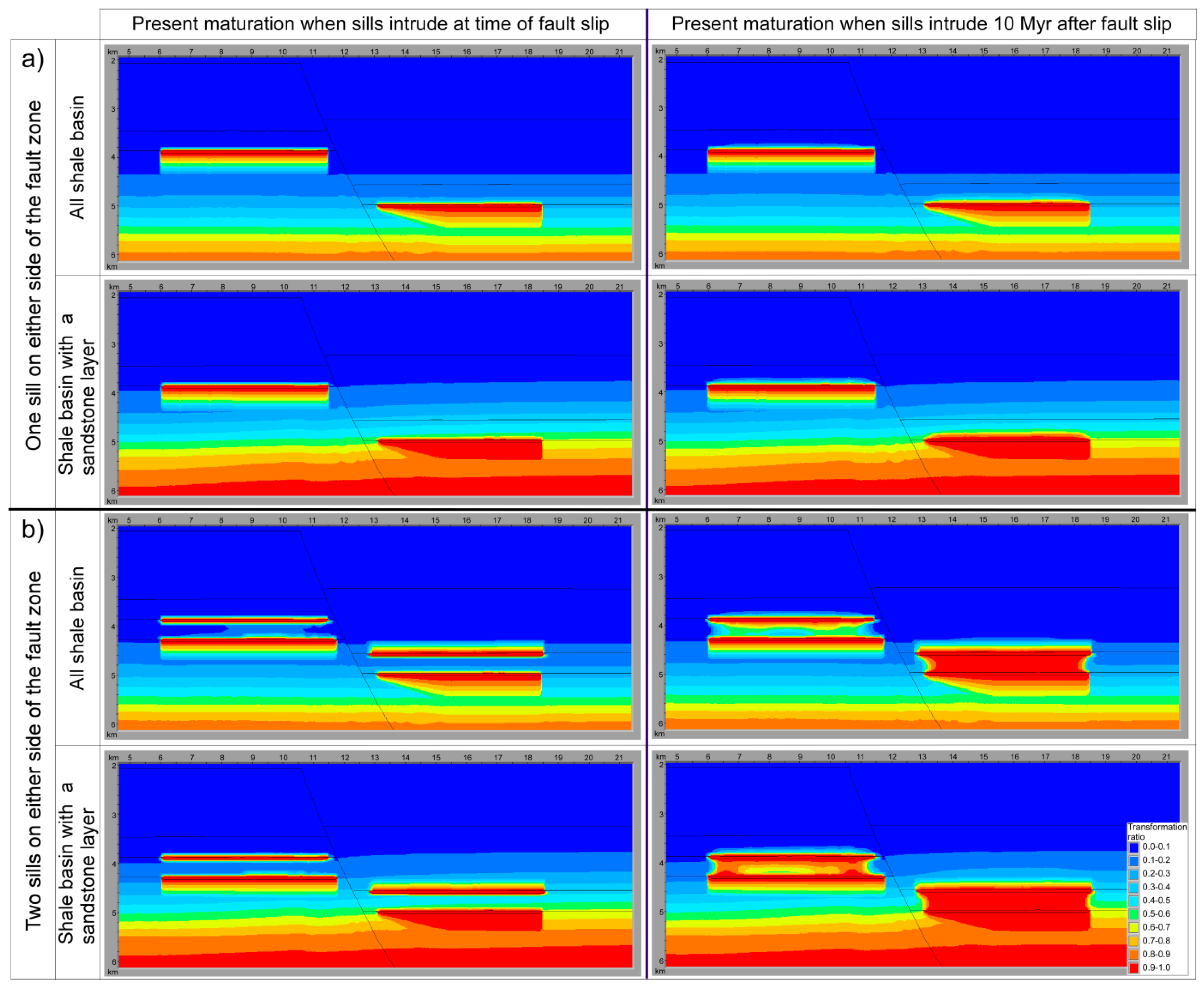
| Simulation Set | Tested Parameter | Tested Values | Fault Displacement | Time Span of Faulting and Deposition | Fault Angle | Thermal Conductivity/Heat Capacity | Basal Heat Flow | Restoration Method |
|---|---|---|---|---|---|---|---|---|
| Set 1 | Fault displacement | 1200 m 500 m 1000 m 2000 m 3000 m | X | 10 kyr | Original | All shale | m−2 | Vertical shear |
| Set 2 | Time span of faulting and deposition | 10 kyr 1 Myr 5 Myr 10 Myr 20 Myr | 1200 m | X | Original | All shale | m−2 | Vertical shear |
| Set 3 | Fault angle | Original Steepest Less steep Least steep | 1200 m | 10 kyr | X | All shale | m−2 | Vertical shear |
| Set 4 | Thermal conductivity/ Heat capacity | All shale All sandstone Sh basin w/sst layer Sst basin w/sh layer | 1200 m | 10 kyr | Original | X | m−2 | Vertical shear |
| Set 5 | Basal heat flow | m−2 40 m−2 60 m−2 80 m−2 | 1200 m | 10 kyr | Original | All shale | X | Vertical shear |
| Set 6 | Restoration method | Vertical shear No fault restoration 10° ant. inc. shear 20° ant. inc. shear 30° ant. inc. shear 10° synth. inc. shear | 1200 m | 10 kyr | Original | All shale | m−2 | X |
| Porosity-Depth Trend | Conductivity (kv) (W·m−1·K−1) | Heat Capacity | |||
|---|---|---|---|---|---|
| Lithology | Surface Porosity | Exponential Constant (km−1) | Low Porosity | High Porosity | (J·kg−1·K−1) |
| Shale (Default) | 0.63 | 0.51 | 3.00 (6%) | 2.80 (60%) | 1190 |
| Sandstone (Default) | 0.45 | 0.27 | 3.30 (6%) | 1.50 (40%) | 1080 |
| Basement, metamorphic | 3.10 | 3.10 | 1100 | ||
| Magmatic intrusions | 3.10 | 3.10 | 1100 | ||
| Asthenosphere | 3.50 | 3.50 | 1100 | ||
| Shale, average conductivity | 0.63 | 0.51 | 1.98 (6%) | 1.19 (60%) | 1190 |
| Shale, max. conductivity | 0.63 | 0.51 | 4.08 (6%) | 2.08 (60%) | 1190 |
| Sandstone, average conductivity | 0.45 | 0.27 | 2.36 (6%) | 1.72 (40%) | 1080 |
| Sandstone, max. conductivity | 0.45 | 0.27 | 6.24 (6%) | 4.20 (40%) | 1080 |
| Shale, min. heat capacity | 0.63 | 0.51 | 3.00 (6%) | 2.80 (60%) | 840 |
| Shale, max. heat capacity | 0.63 | 0.51 | 3.00 (6%) | 2.80 (60%) | 1420 |
| Sandstone, min. heat capacity | 0.45 | 0.27 | 3.30 (6%) | 1.50 (40%) | 760 |
| Sandstone, max. heat capacity | 0.45 | 0.27 | 3.30 (6%) | 1.50 (40%) | 3350 |
© 2019 by the authors. Licensee MDPI, Basel, Switzerland. This article is an open access article distributed under the terms and conditions of the Creative Commons Attribution (CC BY) license (http://creativecommons.org/licenses/by/4.0/).
Share and Cite
Sydnes, M.; Fjeldskaar, W.; Grunnaleite, I.; Løtveit, I.F.; Mjelde, R. Transient Thermal Effects in Sedimentary Basins with Normal Faults and Magmatic Sill Intrusions—A Sensitivity Study. Geosciences 2019, 9, 160. https://doi.org/10.3390/geosciences9040160
Sydnes M, Fjeldskaar W, Grunnaleite I, Løtveit IF, Mjelde R. Transient Thermal Effects in Sedimentary Basins with Normal Faults and Magmatic Sill Intrusions—A Sensitivity Study. Geosciences. 2019; 9(4):160. https://doi.org/10.3390/geosciences9040160
Chicago/Turabian StyleSydnes, Magnhild, Willy Fjeldskaar, Ivar Grunnaleite, Ingrid Fjeldskaar Løtveit, and Rolf Mjelde. 2019. "Transient Thermal Effects in Sedimentary Basins with Normal Faults and Magmatic Sill Intrusions—A Sensitivity Study" Geosciences 9, no. 4: 160. https://doi.org/10.3390/geosciences9040160
APA StyleSydnes, M., Fjeldskaar, W., Grunnaleite, I., Løtveit, I. F., & Mjelde, R. (2019). Transient Thermal Effects in Sedimentary Basins with Normal Faults and Magmatic Sill Intrusions—A Sensitivity Study. Geosciences, 9(4), 160. https://doi.org/10.3390/geosciences9040160




